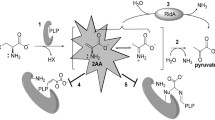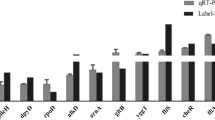Abstract
Introduction
ClpXP protease is an important proteolytic system in Salmonella enterica serovar typhimurium (S. typhimurium). Inactivation of ClpXP by deletion of clpP resulted in overproduction of RpoS and a growth defect phenotype. Only one report has indicated that deleting rpoS can restore the growth of a S. typhimurium clpP mutant to the wild-type level. Whether overproduction of RpoS is responsible for the growth deficiency resulting from clpP disruption and how ClpXP affects the cell metabolism of S. typhimurium remain to be elucidated.
Objectives
The aim of this study is to investigate the effect of ClpXP on cell metabolism of S. typhimurium and explore the possible co-effect of RpoS associated with ClpXP in cell metabolism.
Method
We constructed a clpP rpoS double deletion mutant TT-19 (ΔclpP ΔrpoS TT-1) using a two-step phage transduction technique. We then compared the metabolite fingerprints of Salmonella rpoS deletion mutant TT-14 (ΔrpoS TT-1), clpP deletion mutant TT-16 (ΔclpP TT-1), and clpP rpoS double deletion mutant TT-19 (ΔclpP ΔrpoS TT-1) with those of the wild-type strain TT-1 by using gas chromatography coupled with mass spectrometry (GC–MS).
Results
Deletion of rpoS recovered only a part of the growth of Salmonella clpP mutant. Further metabolome analysis indicated that clpP disruption changed the levels of 16 extra- and 19 intracellular substances, while the extracellular concentrations of 4 compounds (serine, l-5-oxoproline, l-glutamic acid, and l-tryptophan) and intracellular concentrations of 10 compounds (l-isoleucine, glycine, serine, l-methionine, l-phenylalanine, malic acid, citric acid, urea, putrescine, and 6-hydroxypurine) returned to their wild-type levels when rpoS was also deleted.
Conclusion
ClpXP affects the cell metabolism of S. typhimurium partially in an RpoS-dependent manner.





Similar content being viewed by others
References
Alexopoulos, J. A., Guarne, A., & Ortega, J. (2012). ClpP: A structurally dynamic protease regulated by AAA+ proteins. Journal of Structural Biology, 179, 202–210.
Baker, T. A., & Sauer, R. T. (2012). ClpXP, an ATP-powered unfolding and protein-degradation machine. Biochimica et biophysica acta, 1823, 15–28.
Bang, I. S., Frye, J. G., McClelland, M., Velayudhan, J., & Fang, F. C. (2005). Alternative sigma factor interactions in Salmonella: Sigma and sigma promote antioxidant defences by enhancing sigma levels. Molecular Microbiology, 56, 811–823.
Brickman, T. J., & Armstrong, S. K. (1996). The ornithine decarboxylase gene odc is required for alcaligin siderophore biosynthesis in Bordetella spp.: Putrescine is a precursor of alcaligin. Journal of bacteriology, 178, 54–60.
Chevance, F. F., & Hughes, K. T. (2008). Coordinating assembly of a bacterial macromolecular machine. Nature Reviews Microbiology, 6, 455–465.
Damerau, K., & St John, A. C. (1993). Role of Clp protease subunits in degradation of carbon starvation proteins in Escherichia coli. Journal of Bacteriology, 175, 53–63.
De Bruijn, I., & Raaijmakers, J. M. (2009). Regulation of cyclic lipopeptide biosynthesis in Pseudomonas fluorescens by the ClpP protease. Journal of Bacteriology, 191, 1910–1923.
Efiuvwevwere, B., Gorris, L., Smid, E., & Kets, E. (1999). Mannitol-enhanced survival of Lactococcus lactis subjected to drying. Applied Microbiology and Biotechnology, 51, 100–104.
Fang, F. C., Libby, S. J., Buchmeier, N. A., Loewen, P. C., Switala, J., Harwood, J., & Guiney, D. G. (1992). The alternative sigma factor katF (rpoS) regulates Salmonella virulence. Proceedings of the National Academy of Sciences, 89, 11978–11982.
Foster, J. W. (2004). Escherichia coli acid resistance: Tales of an amateur acidophile. Nature Reviews Microbiology, 2, 898–907.
Frees, D., Qazi, S. N., Hill, P. J., & Ingmer, H. (2003). Alternative roles of ClpX and ClpP in Staphylococcus aureus stress tolerance and virulence. Molecular Microbiology, 48, 1565–1578.
Gottesman, S. (2003). Proteolysis in bacterial regulatory circuits 1. Annual Review of Cell and Developmental Biology, 19, 565–587.
Hayashi, S. I., & Lin, E. (1965). Product induction of glycerol kinase in Escherichia coli. Journal of Molecular Biology, 14, 515IN16-521.
Heller, K. B., Lin, E. C., & Wilson, T. H. (1980). Substrate specificity and transport properties of the glycerol facilitator of Escherichia coli. Journal of Bacteriology, 144, 274–278.
Hummel, J., Selbig, J., Walther, D., & Kopka, J. (2007). The Golm Metabolome Database: A database for GC-MS based metabolite profiling Metabolomics. In J. Nielsen, & M. Jewett (Eds.) Metabolomics (pp. 75–95). Berlin: Springer.
Jensen, M. Ø., Park, S., Tajkhorshid, E., & Schulten, K. (2002). Energetics of glycerol conduction through aquaglyceroporin GlpF. Proceedings of the National Academy of Sciences, 99, 6731–6736.
Kajfasz, J. K., Abranches, J., & Lemos, J. A. (2011). Transcriptome analysis reveals that ClpXP proteolysis controls key virulence properties of Streptococcus mutans. Microbiology (Reading, England), 157, 2880–2890.
Kets, E. P., Galinski, E. A., De Wit, M., De Bont, J. A., & Heipieper, H. J. (1996). Mannitol, a novel bacterial compatible solute in Pseudomonas putida S12. Journal of Bacteriology, 178, 6665–6670.
Kingsley, R. A., Msefula, C. L., Thomson, N. R., Kariuki, S., Holt, K. E., Gordon, M. A., et al. (2009). Epidemic multiple drug resistant Salmonella typhimurium causing invasive disease in sub-Saharan Africa have a distinct genotype. Genome Research, 19, 2279–2287.
Klein, K., Steinberg, R., Fiethen, B., & Overath, P. (1971). Fatty acid degradation in Escherichia coli. An inducible system for the uptake of fatty acids and further characterization of old mutants. European Journal of Biochemistry, 19, 442–450.
Knudsen, G. M., Nielsen, M. B., Thomsen, L. E., Aabo, S., Rychlik, I., & Olsen, J. E. (2014). The role of ClpP, RpoS and CsrA in growth and filament formation of Salmonella enterica serovar Typhimurium at low temperature. BMC Microbiology, 14, 208.
Knudsen, G. M., Olsen, J. E., Aabo, S., Barrow, P., Rychlik, I., & Thomsen, L. E. (2013). ClpP deletion causes attenuation of Salmonella typhimurium virulence through mis-regulation of RpoS and indirect control of CsrA and the SPI genes. Microbiology (Reading, England), 159, 1497–1509.
Lee, I. S., Lin, J., Hall, H. K., Bearson, B., & Foster, J. W. (1995). The stationary-phase sigma factor sigma S (RpoS) is required for a sustained acid tolerance response in virulent Salmonella typhimurium. Molecular Microbiology, 17, 155–167.
Lin, E. (1976). Glycerol dissimilation and its regulation in bacteria. Annual Reviews in Microbiology, 30, 535–578.
Maloy, S. R., & Nunn, W. D. (1981). Selection for loss of tetracycline resistance by Escherichia coli. Journal of Bacteriology, 145, 1110–1111.
Martínez-Gómez, K., Flores, N., Castañeda, H. M., Martínez-Batallar, G., Hernández-Chávez, G., Ramírez, O. T., et al. (2012). New insights into Escherichia coli metabolism: Carbon scavenging, acetate metabolism and carbon recycling responses during growth on glycerol. Microbial Cell Factories, 11, 46.
Monack, D. M., Raupach, B., Hromockyj, A. E., & Falkow, S. (1996). Salmonella typhimurium invasion induces apoptosis in infected macrophages. Proceedings of the National Academy of Sciences, 93, 9833–9838.
Patten, C. L., Kirchhof, M. G., Schertzberg, M. R., Morton, R. A., & Schellhorn, H. E. (2004). Microarray analysis of RpoS-mediated gene expression in Escherichia coli K-12. Molecular Genetics and Genomics, 272, 580–591.
Qian, Z. G., Xia, X. X., & Lee, S. Y. (2009). Metabolic engineering of Escherichia coli for the production of putrescine: A four carbon diamine. Biotechnology and Bioengineering, 104, 651–662.
Rahman, M., Hasan, M. R., Oba, T., & Shimizu, K. (2006). Effect of rpoS gene knockout on the metabolism of Escherichia coli during exponential growth phase and early stationary phase based on gene expressions, enzyme activities and intracellular metabolite concentrations. Biotechnology and Bioengineering, 94, 585–595.
Richey, D. P., & Lin, E. C. (1972). Importance of facilitated diffusion for effective utilization of glycerol by Escherichia coli. Journal of Bacteriology, 112, 784–790.
Robertson, G. T., Ng, W. L., Foley, J., Gilmour, R., & Winkler, M. E. (2002). Global transcriptional analysis of clpP mutations of type 2 Streptococcus pneumoniae and their effects on physiology and virulence. Journal of Bacteriology, 184, 3508–3520.
Rychlik, I., & Barrow, P. A. (2005). Salmonella stress management and its relevance to behaviour during intestinal colonisation and infection. FEMS Microbiology Reviews, 29, 1021–1040.
Salanitro, J. P., & Wegener, W. S. (1971). Growth of Escherichia coli on short-chain fatty acids: Nature of the uptake system. Journal of Bacteriology, 108, 893–901.
Sanno, Y., Wilson, T. H., & Lin, E. C. (1968). Control of permeation to glycerol in cells of Escherichia coli. Biochemical and Biophysical Research Communications, 32, 344–349.
Schneider, J., & Wendisch, V. F. (2011). Biotechnological production of polyamines by bacteria: Recent achievements and future perspectives. Applied Microbiology and Biotechnology, 91, 17–30.
Sturgill, G., & Rather, P. N. (2004). Evidence that putrescine acts as an extracellular signal required for swarming in Proteus mirabilis. Molecular Microbiology, 51, 437–446.
Tang, T., Gao, Q., Barrow, P., Wang, M., Cheng, A., Jia, R., et al. (2015). Development and evaluation of live attenuated Salmonella vaccines in newly hatched duckings. Vaccine, 33, 5564–5571.
Thomsen, L., Olsen, J., Foster, J., & Ingmer, H. (2002). ClpP is involved in the stress response and degradation of misfolded proteins in Salmonella enterica serovar Typhimurium. Microbiology (Reading, England), 148, 2727–2733.
Tomoyasu, T., Ohkishi, T., Ukyo, Y., Tokumitsu, A., Takaya, A., Suzuki, M., et al. (2002). The ClpXP ATP-dependent protease regulates flagellum synthesis in Salmonella enterica serovar Typhimurium. Journal of Bacteriology, 184, 645–653.
Tomoyasu, T., Takaya, A., Isogai, E., & Yamamoto, T. (2003). Turnover of FlhD and FlhC, master regulator proteins for Salmonella flagellum biogenesis, by the ATP-dependent ClpXP protease. Molecular Microbiology, 48, 443–452.
Wang, C., Li, M., Dong, D., Wang, J., Ren, J., & Otto, M. (2007). Role of ClpP in biofilm formation and virulence of Staphylococcus epidermidis. Microbes and Infection, 9, 1376–1383.
Way, J., Davis, M., Morisato, D., Roberts, D., & Kleckner, N. (1984). New Tn10 derivatives for transposon mutagenesis and for construction of lacZ operon fusions by transposition. Gene, 32, 369–379.
Webb, C., Moreno, M., Wilmes-Riesenberg, M., Curtiss, R., & Foster, J. W. (1999). Effects of DksA and ClpP protease on sigma S production and virulence in Salmonella typhimurium. Molecular Microbiology, 34, 112–123.
Wisselink, H., Weusthuis, R., Eggink, G., Hugenholtz, J., & Grobben, G. (2002). Mannitol production by lactic acid bacteria: A review. International Dairy Journal, 12, 151–161.
Yamamoto, N., & Droffner, M. L. (1985). Mechanisms determining aerobic or anaerobic growth in the facultative anaerobe Salmonella typhimurium. Proceedings of the National Academy of Sciences, 82, 2077–2081.
Acknowledgements
This study is supported by the China Postdoctoral Science Foundation (No. 2016M602691), Sichuan Science & Technology Department Foundation (No. 2017JY0241), Young Scholar Research Grants of Sichuan University (No. 2016SCU11005) and Natural Science Foundation of China (No. 31570924).
Author information
Authors and Affiliations
Contributions
TT, QG, FB, XP and CW designed the experiments. BZ, XZ and JX guided the experiments. TT performed the experiments. TT analyzed the data. TT and FB wrote this paper.
Corresponding author
Ethics declarations
Conflict of interest
All authors declare that they have no conflict of interest.
Ethical approval
This article does not contain any studies with human participants or animals performed by any of the authors.
Electronic supplementary material
Below is the link to the electronic supplementary material.
Rights and permissions
About this article
Cite this article
Tang, T., Gao, Q., Lin, H. et al. ClpXP affects the cell metabolism of Salmonella typhimurium partially in an RpoS-dependent manner. Metabolomics 13, 157 (2017). https://doi.org/10.1007/s11306-017-1296-6
Received:
Accepted:
Published:
DOI: https://doi.org/10.1007/s11306-017-1296-6




